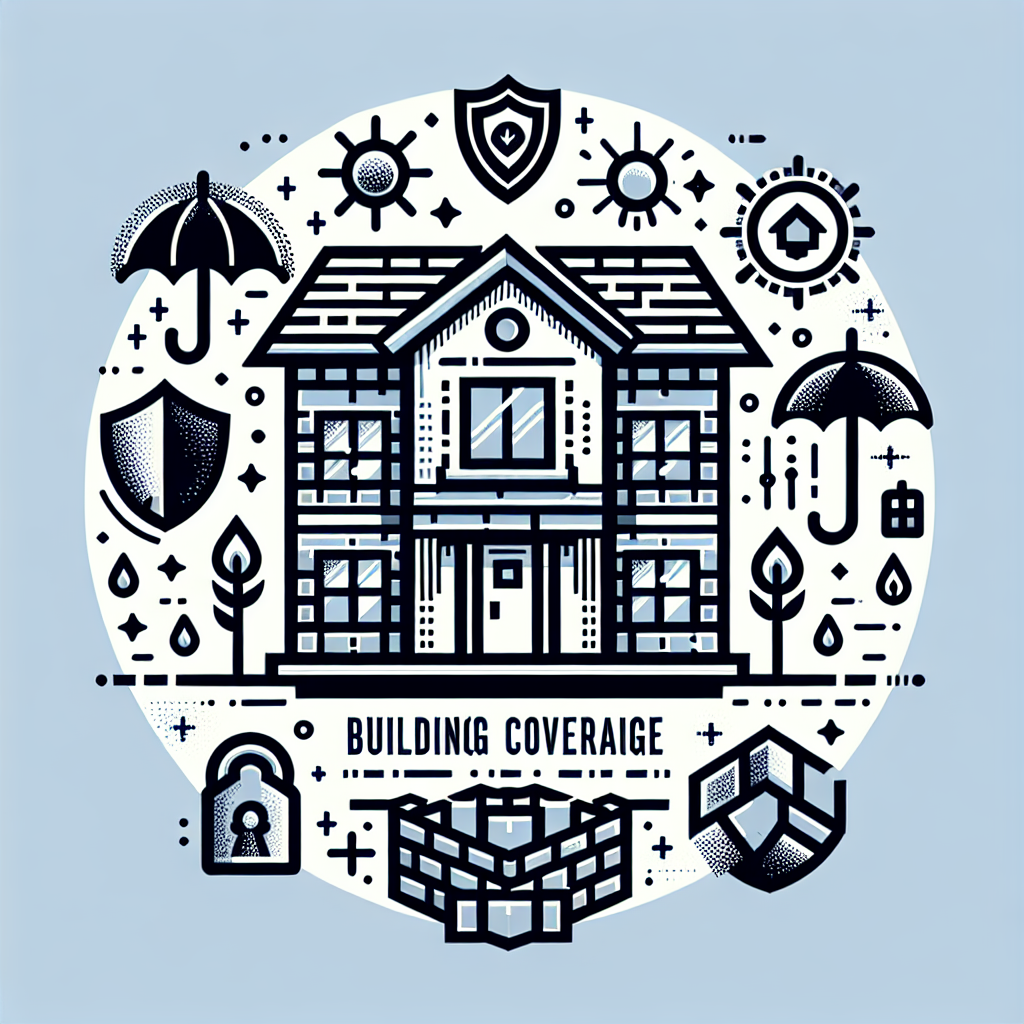Filed under Home Insurance on
Home Insurance Building Coverage Explained

Most homeowners know they need insurance, but far fewer can confidently explain what’s protected if the structure itself is damaged. Walls, roof, foundation, systems, and fixtures are where the biggest dollars live—and where misunderstandings can be costly. This guide breaks down the mechanics of home insurance building coverage, why it matters, and how to tailor it so your house can be rebuilt after a worst-case scenario.
What “Building Coverage” Actually Means
In a standard homeowners policy (often called HO-3 or HO-5), the portion that insures the physical structure is known as Coverage A, commonly called dwelling coverage. When people talk about home insurance building coverage, they’re talking about the money set aside to rebuild or repair the home’s structure if it’s damaged by a covered peril.
Coverage A protects the permanent parts of your home: the roof, exterior and interior walls, insulation, flooring, built-in cabinetry, counters, attached garage, porch, deck, and the systems that make the place livable (electrical, plumbing, HVAC). It’s separate from Coverage B (other structures like a detached garage or fence), Coverage C (personal property), and Coverage D (loss of use/additional living expenses).
What’s Usually Covered
Structural components
- Foundation, framing, roof, and exterior finishes
- Windows, doors, and attached structures like an attached garage or deck
- Built-in fixtures: cabinets, countertops, sinks, tubs, and permanently installed flooring
- Essential systems: HVAC, electrical, and plumbing inside the home’s envelope
Common covered causes of loss
- Fire and smoke
- Wind and hail (subject to state and policy-specific deductibles or exclusions)
- Lightning and power surge (for the structure; electronics are personal property)
- Ice, snow, and sleet weight
- Vandalism and malicious mischief
- Explosions and vehicle impacts
Insurers detail covered causes in your policy language. The broader HO-5 form generally includes more open-peril coverage, but exclusions still apply. Understanding the scope of home insurance building coverage helps you anticipate what you’d pay out of pocket if something goes wrong.
What’s Typically Not Covered
- Flood (rising water from outside) — usually requires a separate policy
- Earthquake and earth movement — often separate coverage
- Wear and tear, rot, deterioration, and maintenance issues
- Mold, rust, and long-term seepage (unless endorsed, with limits)
- Power failure off premises, government action, and war
- Manufacturer defects, construction defects, or faulty workmanship (unless sudden damage from a covered peril ensues)
- Water backup from sewers or drains without a specific endorsement
Exclusions vary by insurer and state. Read your declarations page and policy booklet for the fine print—especially around water, the trickiest coverage area for homeowners.
How Much Building Coverage Do You Need?
The single most important number on your policy is the Coverage A limit. It should match what it would cost to rebuild your home from the ground up using similar materials and quality, not what you paid for the property or what it could sell for. Market value reflects land value and local demand; rebuilding cost reflects materials, labor, permits, debris removal, and sometimes new code requirements.
Between 2021 and 2023, many regions saw construction costs jump sharply, driven by material shortages, labor constraints, and supply chain disruptions. Industry groups and the Bureau of Labor Statistics reported notable increases in the cost of lumber, roofing, and skilled trades during that period, and while some inputs have eased, volatility continues. That’s why your home insurance building coverage limit should be revisited annually.
Estimating your rebuild cost
- Measure square footage: finished living area, plus other livable structures attached to the home.
- Assess quality level: basic, standard, custom, or high-end finishes impact cost.
- Factor complexity: unique architecture, steep roofs, porches, and built-ins increase labor hours.
- Consider local costs: labor rates vary dramatically by region and even within metro areas.
A quick back-of-the-napkin starting point is cost per square foot. In many U.S. markets, a standard rebuild might range from $175 to $350 per square foot, while high-end custom homes can exceed $500. These are broad ranges; ask your agent to run a professional replacement cost estimator specific to your ZIP code and home details.
Example: A 2,200-square-foot home at $250 per square foot suggests a $550,000 dwelling limit, plus extra for debris removal, code upgrades, and seasonal inflation. If your home has custom features—stonework, millwork, imported tile—bump the estimate accordingly.
Replacement cost vs. actual cash value
- Replacement Cost (RC): Pays the full cost to rebuild with like kind and quality, without depreciation. Most lenders require this for the dwelling.
- Actual Cash Value (ACV): Pays replacement cost minus depreciation. This saves premium but can leave large gaps at claim time.
Some carriers apply ACV to specific components—especially older roofs—unless you add an endorsement. Review this carefully; roof claims are common, and ACV can reduce a payout significantly if your shingles are nearing end of life.
Extended and guaranteed replacement options
- Extended Replacement Cost: Provides an extra cushion (often 10–50%) above your Coverage A limit if costs surge after a large disaster.
- Guaranteed Replacement Cost: Covers the full rebuild regardless of limit, where available. Not offered by every insurer or in every state.
These features have become more valuable as communities face widespread events. NOAA recorded a record number of separate billion-dollar weather and climate disasters in 2023, and large-scale events can temporarily push construction costs even higher.
Key Policy Features and Endorsements
- Ordinance or Law Coverage: Pays for upgrades required by current building codes when repairing or rebuilding. Often included at 10% of Coverage A; many homeowners choose 25–50% in older homes or code-heavy jurisdictions.
- Inflation Guard: Automatically increases your dwelling limit during the policy term to keep pace with construction inflation.
- Water Backup Endorsement: Adds coverage for damage from backed-up sewers or drains. Limits vary; choose enough to handle a finished basement loss.
- Matching of Siding/Roof: Helps replace undamaged sections to achieve a uniform appearance when a partial repair would leave obvious mismatches.
- Roof Surface Loss Settlement: Endorsements can upgrade from ACV to RC on older roofs, or vice versa. Read your form closely.
Your agent can help tailor endorsements to the home’s age, materials, and local risk profile. In many cases, modest endorsements meaningfully improve how home insurance building coverage performs at claim time.
Deductibles and Special Deductibles
Most policies use a flat all-perils deductible (e.g., $1,000 or $2,500) for standard claims. In some states, wind/hail or hurricane deductibles apply as a percentage of the dwelling limit, typically 1–5%. On a $500,000 dwelling limit, a 2% wind deductible yields a $10,000 out-of-pocket. Know which deductibles apply in your state and weigh the premium savings of a higher deductible against your emergency fund.
Common Misunderstandings to Avoid
- Market Value vs. Rebuild Cost: A hot real estate market may push your home’s sale price far above rebuild cost; in other areas, land value is low and rebuild costs exceed market value. Insure to rebuild cost.
- Detached Structures: Fences, sheds, and standalone garages usually fall under Coverage B at around 10% of your dwelling limit. If you have a large workshop or extensive fencing, increase this limit.
- Renovations: Upgrades like finishing a basement or adding custom cabinetry increase rebuild cost. Update your policy before the project starts; keep receipts and plans.
- Short-Term Rentals: Occasional rentals can alter coverage. You may need endorsements or a different policy type if you regularly host paying guests.
- Vacancy: Extended vacancy can restrict coverage. Tell your insurer if the home will be unoccupied for longer than your policy allows.
Regional Risk and Market Trends
Insurance pricing and availability reflect real-world risk and reinsurance costs. In wildfire-prone regions, insurers may require defensible space or Class A fire-rated roofs. Along the Gulf and Atlantic coasts, windstorm deductibles are common and roof age can affect eligibility. In hail corridors, some carriers apply ACV to older roofs without an upgrade endorsement.
Industry analyses from organizations such as the Insurance Information Institute and AM Best have highlighted how rising catastrophe losses, reinsurance pricing, and construction inflation are pushing premiums upward in many states. Homeowners who invest in mitigation—like impact-rated roofing, fire-resistant landscaping, water leak sensors, and whole-home surge protection—often qualify for credits and reduce the likelihood of a severe claim.
The Claims Journey for Structural Damage
- Safety first: Secure the area and prevent further damage. Temporary repairs and tarps are typically covered as part of the claim.
- Document everything: Photos, video walkthroughs, and a written timeline. Keep receipts for temporary repairs and extra living expenses.
- Contact your insurer: Open the claim and confirm which deductibles apply. Ask whether you need multiple estimates.
- Meet the adjuster: Be present. Share your documentation, point out hidden or less obvious damage, and discuss code compliance requirements.
- Choose reputable contractors: Seek licensed, insured professionals. Beware of door-to-door storm chasers pushing assignment of benefits agreements without scrutiny.
- Track payments: Insurers may issue multiple checks, including holdbacks for recoverable depreciation paid after repairs are complete when you have replacement cost coverage.
If disputes arise, ask about the appraisal process available in your policy. A well-prepared claim file and objective estimates are your best leverage when filing a home insurance building coverage claim.
Smart Ways to Save Without Undersinsuring
- Bundle auto and home for multi-policy discounts.
- Increase your all-perils deductible to a level you can truly afford, but not beyond your emergency reserves.
- Invest in mitigation: Class 4 impact-resistant roofing, monitored water leak detection, wildfire hardening, and updated electrical/plumbing.
- Ask for discounts: New roof, protective devices, claims-free history, and loyalty credits.
- Shop periodically: Market conditions change; review quotes every 1–2 years while considering service and financial strength—not just price.
- Update your replacement cost data: Accurate home details can prevent being overcharged or underinsured.
Condo Owners: Special Building Coverage Considerations
Condo insurance (HO-6) works differently because a master association policy covers common elements and, depending on bylaws, some or all of the building structure. Your personal policy fills the gaps “walls-in.” You’ll want to understand whether the master policy is “bare walls,” “single entity,” or “all-in,” because that determines how much structural coverage you need for interior finishes and fixtures.
- Improvements and Betterments: If you upgraded flooring, cabinets, or fixtures, insure those at their current replacement cost.
- Loss Assessment: Helps cover your share of certain special assessments after a covered loss to the building or common areas, subject to policy limits and triggers.
- Water Damage: Condo losses often involve water from above or adjacent units. Consider water backup endorsements and adequate limits for your interior build-out.
Read your condo declaration and bylaws before setting limits. For many owners, home insurance building coverage works differently in a condo context, and proper coordination with the association’s master policy is essential.
Landlords and Short-Term Rentals
If you rent out a property, you likely need a dwelling fire policy (such as DP-3) rather than a standard homeowners policy. These policies focus on the structure and can add loss of rents coverage if the home is uninhabitable after a covered loss. Tenant belongings are not covered—your renters should carry renters insurance. If you do occasional short-term rentals, talk to your agent; some carriers require a specific endorsement or a different policy form to keep building coverage intact.
What to Ask Your Agent Each Year
- Is my Coverage A limit sufficient to rebuild today, given current construction costs?
- Do I have replacement cost on the dwelling and the roof? Any age-based limitations?
- What are my wind/hail or hurricane deductibles, and how would they apply?
- How much ordinance or law coverage is included? Should I increase it?
- Do I have water backup coverage for the basement or lower level? What limit?
- Are there discounts available for mitigation upgrades or smart home devices?
- Have we correctly listed all detached structures and high-value features?
- What endorsements could improve how home insurance building coverage responds?
Scenario Walkthroughs
Wind and hail roof loss
A severe hailstorm damages your 15-year-old roof. With replacement cost coverage on the roof, the insurer pays the cost to replace with similar shingles, minus your deductible, and reimburses recoverable depreciation after completion. With ACV, depreciation might reduce the payout significantly, leaving you to cover a larger share.
Kitchen fire
A cooking fire damages cabinets, appliances, and portions of the ceiling. Building coverage repairs structure and built-in fixtures; personal property coverage handles moveable items like small appliances and cookware. If the city requires upgraded electrical components under current code, ordinance or law coverage pays that extra cost up to its limit.
Frozen pipe burst
A winter freeze bursts a pipe inside the wall. Drywall, insulation, and flooring are damaged. Building coverage applies because a sudden and accidental discharge of water from a plumbing system is typically covered. If you were away and failed to maintain heat or drain systems as required by your policy, coverage could be restricted—maintenance matters.
Documentation Tips That Pay Off
- Create a simple home profile: year built, square footage, materials, roof type and age, major upgrades with dates and costs.
- Keep digital copies of permits and contractor invoices; they help verify the home’s rebuild features.
- Record a video walkthrough annually. It’s easy evidence during a claim.
- After renovations, alert your agent immediately to adjust limits and endorsements.
FAQs
Is building coverage required by my mortgage?
Yes. Lenders require sufficient dwelling coverage—usually on a replacement cost basis—to protect their collateral. They may also require specific perils like wind or hurricane coverage depending on your location.
How often should I adjust my limit?
Review at least annually and after any renovation. Construction inflation can move faster than general inflation, and large jumps can occur after regional disasters.
What’s the difference between Coverage A and Coverage B?
Coverage A is the primary dwelling. Coverage B insures other structures not attached to your home, like a detached garage or fence, typically at 10% of Coverage A by default.
Do I need separate flood insurance?
If you are exposed to rising water from outside, yes. Standard homeowners policies exclude flood. Consider a policy through the National Flood Insurance Program or a private flood insurer.
What about earthquakes?
Earth movement is typically excluded. In high-risk areas, you can purchase an earthquake policy or endorsement.
A Practical Recap
Start with an accurate rebuild estimate, not your home’s market value. Choose replacement cost for the structure wherever possible, consider extended or guaranteed replacement options, and add endorsements that address your home’s specific vulnerabilities. Build in protection for code upgrades and water-related risks, and keep documentation current to streamline claims.
Lastly, as extreme weather events become more frequent and construction costs remain volatile, revisit your policy every year or after any major change to the property. A precise, well-maintained policy is the difference between a painful partial payout and a smooth rebuild when you need it most. By proactively calibrating your home insurance building coverage, you’ll put financial muscle behind the roof and walls that protect everything else.
If you remember only one action item, make it this: schedule a 20-minute policy review with your agent this week and confirm your home insurance building coverage limit, roof settlement terms, ordinance or law amount, and water backup protection. Small adjustments today can save enormous headaches tomorrow.




